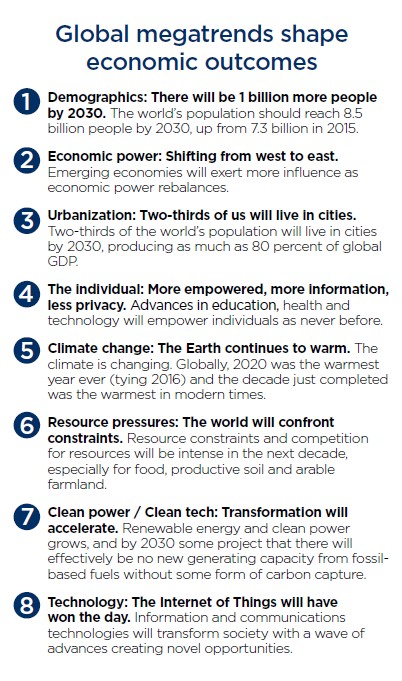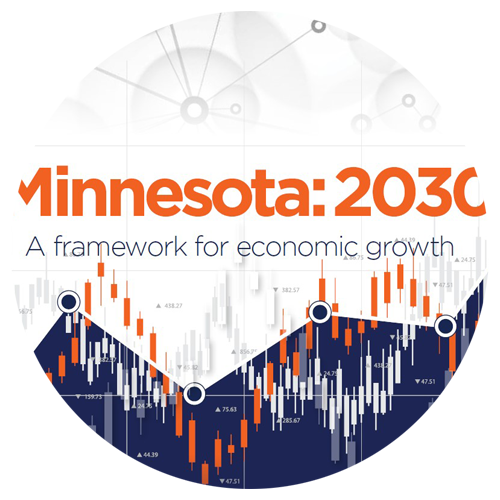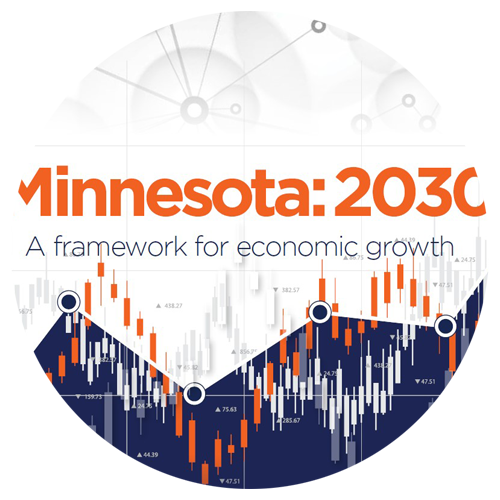National and global competitiveness
Minnesota: 2030
A framework for economic growth
Minnesota's competitiveness nationally and globally helps fuel – or constrain – the state’s economy.
Each year, the Minnesota Chamber of Commerce analyzes and reports on Minnesota’s economic competitiveness in its Business Benchmarks report (mnchamber.com/benchmarks). In the context of this report, it is important to note that Minnesota’s competitive position and competitive landscape influences the state’s economic potential.
Education: With 46.8 percent of adults having earned at least an associate degree, Minnesota ranks 4th for educational attainment. Success is not always broadly shared, however, and Minnesota lags on key measures. This includes the on-time high school graduation rate, ranking 34th at 83 percent, below the national average. Minnesota’s racial achievement gap is also the nation’s worst.
Economic performance: While Minnesota punches above its weight in absolute measures of economic output, its growth has trailed in recent years. At 1.1 percent, Minnesota’s GDP growth ranked 36th nationally in 2019, fourteen spots worse than 2018. Exports contracted 2.1 percent in 2019, moving the state thirteen spots lower to 26th. Minnesota’s job growth ranked 35th in 2020. Jobs contracted 6.8 percent, largely due to COVID, worse than the nation’s -6.4 percent but ten spots better than the state’s dismal ranking of 45th in 2019.
Taxes and cost of living: Affordability cuts both ways. Minnesota benefits from a relatively affordable cost of living, ranked 23rd across all states and below the U.S. average. However, Minnesota’s tax climate is decidedly less competitive than peer states. Minnesota’s tax index is 4th highest in the nation for small businesses and entrepreneurs. Minnesota’s top pass-through and individual income tax rate is 5th in the nation at 9.85 percent. The corporate income tax is 4th highest at 9.8 percent. Overall, Minnesota’s state and local taxes per capita rank 9th highest – at $6,176 – well above the national average of $5,073.
Innovation and entrepreneurship: Minnesota ranked 49th in entrepreneurship and business startup activity in 2019. The five-year business survival rate is strong, however, at 4th overall, and patents per capita ranks 6th.
Reputation: Competitiveness extends beyond taxes and GDP growth. Minnesota’s reputation is not currently measured – and that is a concern. The killing of George Floyd shone a bright light on longstanding social and economic inequities in Minneapolis and Minnesota – highlighting for the nation and world challenges we have struggled to address for much too long. Subsequent public safety concerns compound the challenge – and Minnesota remains under an unwelcome national spotlight. Minnesota enjoys its problem solving reputation. And while there is reputational value in Minnesota finding solutions to the issues of social and economic inequity, the stakes are even higher. The promise of Minnesota: 2030 (and beyond) cannot be accomplished without it.
Global megatrends
Global megatrends are also shaping our economy and influencing Minnesota’s future economic growth. Megatrends are large-scale social, economic, political, environmental or technological shifts driving change in global markets and impacting how people live and work. Because they affect so many and are not easily changed, megatrends are strategic forces shaping the future landscape.










